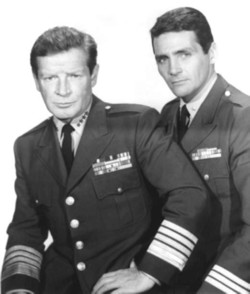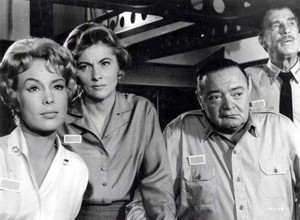| |
The Thunder ChildScience Fiction and Fantasy |
| |
|
| |
|
|
The Thunder Child Television Sourcebooks Voyage to the Bottom of the Sea by Joe Umberto
Voyage to the Bottom of the Sea started its journey as a theatrical release for 20th Century Fox in 1961 with a stellar cast that included Walter Pidgeon, Peter Lorre, Joan Fontaine, Barbara Eden, and Frankie Avalon. Nowadays a few of these names may ring a bell, or roll some eyes, but all the same this was still considered a Hollywood blockbuster destined to sell plenty of tickets, pop-corn and soda. The film introduces us to Admiral Harriman Nelson and his newly commissioned atomic submarine called the Seaview.
Nevertheless, the admiral and submarine still race off to the Pacific to launch a nuclear missile from the Marianas Trench, implementing the notion of fighting fire with fire. Trouble for those on board the sub begins when it emerges there is a saboteur amongst them. But is it a rescued scientist, or the stress-observing psychologist (Fontaine)? Familiar subplots abound but Voyage is big-budget Sci-Fi fun for its day. The film submarine's design is unique in that it features an eight-window bow viewport which gives panoramic undersea views (in the novel of the film by Theodore Sturgeon, the windows are described as "transparent hullplating", a process developed by Nelson as "X-tempered herculite"). The Seaview submarine bow/nose also has a shark-like bottom flare, and the stern has extended V-shaped wing/tail surfaces. In the film, the USOS Seaview (United States Oceanographic Survey) is under the authority of Admiral Nelson and the Bureau of Marine Exploration. The novel mentions the Bureau as being part of the US Department of Science. (Pyramid Books published a novelization of the feature film by Theodore Sturgeon. The book was very successful and was reprinted several times throughout the 1960s). The film is riddled with scientific and technical absurdities (for instance, the Van Allen belt is made up of subatomic particles which cannot catch fire, even if there were oxygen in space), and the plot is driven by piling one disaster on top of another (a minefield, a hostile submarine, a giant squid, a near-mutiny and a religious fanatic). Near the end of the film the saboteur is unmasked, then falls into the sub's aquarium during a fight and is eaten by a shark, which the sub's marine biologist (Lorre) just happens to have on board for research purposes. Eventually, despite the efforts of the fanatic to prevent it, the sub launches a nuclear missile into the belt, extinguishing the fire and saving the world. After the receipts were counted the film was a success and a TV series on the ABC network was planned. The cast and story line was reworked for an episodic Sci-Fi adventure series. The Voyage to the Bottom of the Sea TV series premiered in 1964 and ran until 1968. The series chronicled the adventures of the world's first privately owned nuclear submarine, the SSRN Seaview. Designed by Admiral Nelson, she is a ship in the service of the Nelson Institute of Marine Research and her primary mission is oceanographic research. Though the show is known for its occasional "monster" episodes, many plots were thinly disguised commentaries of what was seen happening on the evening news. Such plotlines as nuclear doomsday, environmental pollution, foreign intrigue, and theft of American technology are all still relevant today as they were at that time.
The most important change in the series occurred during this season when a slightly redesigned Seaview was introduced, along with the Flying Sub. A shuttlecraft type of vehicle, the Flying Sub was launched in a bay under the Seaview. The Flying Sub would wind up being the most recognized element of the series, even more so than the Seaview itself. The final two seasons cemented the shift towards campy storylines that were popular in the late 1960s. Mummies, werewolves, talking puppets and an evil leprechaun all prowled the passageways of the Seaview. There were also fossil men, flame men, frost men and lobster men. Ratings for the fourth season took a significant drop as the season progressed, but were not drastic enough for ABC to immediately cancel a fifth season for the series. During renewal discussions between Irwin Allen, 20th Century Fox and ABC, Allen instead proposed replacing Voyage with Land of the Giants. Based on a proposal consisting of only a reported two dozen pre-production concept paintings, ABC accepted Allen's proposed new series, and Voyage was cancelled. Voyage to the Bottom of the Sea was the longest running American science fiction television series in broadcasting history, until the fifth season of Star Trek: The Next Generation broke that record.
Web and Bibliography The Thunder Child quick tips:
View the Volcano Seven: Photo page for "Eleven Days to Zero"
|
Recommended Viewing
|
| |
To see our animated navigation bars, please download the Flash Player from Adobe.
All text © 2006, 2007 The Thunder Child unless otherwise credited.
All illustrations retain original copyright.
Please contact us with any concerns as to correct attribution.
Any questions, comments or concerns contact The Thunder Child.










